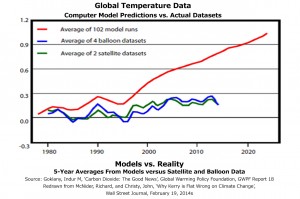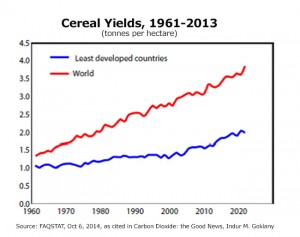Accuracy matters. Bake a cake using self-rising flour when the recipe calls for non-self-rising flour, and much of the cake will end up on the oven floor. Strike a golf ball 1 degree left of center, and a ball flying 250 yards will end up 30 yards to the left its target. Use flawed models in predicting climate change, and the results will be hysteria-inducing projections that fail the test of reality; and that is very much the case with climate change alarmists’ claims of disastrous effects of carbon dioxide emissions on human and environmental wellbeing.
Indur M. Goklany, a member of the U.S. delegation that established the Intergovernmental Panel on Climate Change and helped develop its First Assessment Report, addresses the widespread inaccuracies about carbon dioxide emissions and its impact on people and planet in a new well-documented report produced by the Global Warming Policy Foundation entitled "Carbon Dioxide: The Good News."
Global temperature change has occurred, argues Goklany, but this change is not detrimental He details the benefits of carbon dioxide (CO2), outlines the empirical evidence of the effect of higher CO2 concentrations on human and environmental wellbeing, and explains why alarmists' claims of damage from temperature change are failing to materialize.
Benefits of CO2
Often ignored, CO2 is plant food and essential to life on earth. Moreover, elevated CO2 concentrations:
- yield more, faster and larger growth in plants above and below ground;
- yield larger crops—a 51% increase in cotton and 17% increase in wheat since pre-industrial times;
- yield faster growth of forests—trees in central European forests grew 10-30% faster in 2000 than in 1960; and
- have no discernable impact on marine life, according to the largest peer-review meta-analysis (372 experiments on 44 species).
Claims vs. Reality of CO2's Impact
Goklany compares global warming alarmists' claims of adverse impact with empirical reality (which he backs with several pages of citations):
- claim of growing chronic hunger: Despite a global population increase of 31% to 7.1 billion, available food supplies increased by 44% from 1990/92 to 2011/13. "Consequently, the population suffering from chronic hunger declined by 173 million despite a population increase of 1.7 billion."
- claim of rapidly rising sea levels: Observational studies have failed to detect any acceleration in sea-level rise, and "some studies actually indicate a recent deceleration."
- claim of more intense flooding and droughts: Analysis of monthly precipitation data over global land surface from 1940 to 2009 "indicates the dry areas get wetter while wet areas get drier." A study covering 1940 to 2005 found no relationship between CO2 increase and precipitation.
- claim of extreme weather: There have been an increase in warm days, but "there have been no general increases in the intensity or frequency of other weather extremes, such as hurricanes, tornadoes, floods or droughts." Moreover, "despite a four-fold increase in population and much more complete reporting of such events, since the 1920s deaths from all extreme weather events … have declined by 93%."
- claim of increasing vector-borne disease such as malaria: The global mortality rate for malaria has declined, from 194 per 100,000 in 1900 to 9 per 100,000 in 2012 – a reduction of 95.4%.
- claim of increased dirty water: Between 1990 and 2012, an additional 2.3 billion people gained access to clean water, increasing the global population with such access from 75.9% to 89.3%.
- claim of declining living standards: Living standards as measured by GDP per capita, have never been higher globally. There were over 723 million fewer people living in absolute poverty in 2010 than in 1981, despite the developing world's population increase of 2,174 million; and life expectancy in low-income countries increased from 25-30 years in 1900, to 42 years in 1960, to 62 years today.
Why Claims of Damage Fail to Materialize
Global warming model predictions, like a wayward golf ball, have strayed far off course when compared to reality (see figure).
The reason is that global warming estimates rely on chains of linked, but unvalidated, computer models, the hypotheses and biases of which have not been checked against empirical reality. The author describes this as "chains of models, cascades of uncertainty."
Each chain begins with a climate model, which itself is driven by a set of socioeconomic scenarios based on assumptions for population, economic development and technological change over the entire period of the analysis (often 50–100 years or more). The climate model is followed by various biophysical, economic and other downstream models to estimate changes in different aspects of human activity or welfare, for example agriculture, forestry, health or biodiversity. The uncertain outputs of each upstream model serve as the inputs of the subsequent downstream model, with the uncertainties cascading down the chain so that the individual streams of uncertainty combine into a regular torrent.
These models fail to account for the benefits of CO2 on photosynthesis rates or water-use efficiency, the benefits of warming, variations in precipitation, and adaptation and new technologies since the 1990s.
They implicitly assume that the world of 2100 will not be much different from that of the present … but the world of 2015 is already quite different from that of 1990.
Interestingly, Goklany notes that the Swedish chemist Svante Arrhenius – the father of anthropogenic global warming (AGW) theory and winner of the 1905 Nobel Prize for Chemistry – "deduced that an increase in atmospheric carbon dioxide concentration would benefit mankind by enhancing the growth of plants. Anyone repeating Arrhenius's conclusion today risks being branded as a 'science denier' by some of the more committed proponents of the dangers of AGW."
Yet those like our president who persist in relying on flawed climate change computer models are the true 'science deniers', and they are doomed to embrace prescriptions and policies that will do substantial harm to both people and environment. We would be wise not to follow them.



